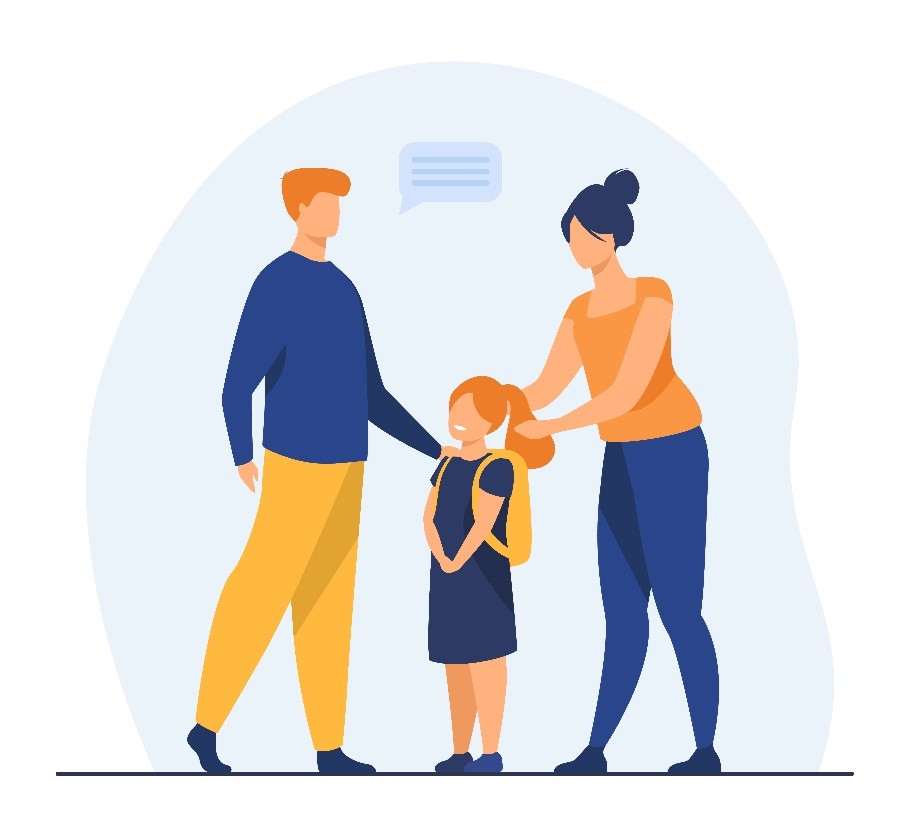Children and adolescents have many different sides to their personalities, just like grownups. Sometimes the kid at school isn't the same kid at home and vice versa. Because of this, open lines of sharing and collaboration between educators and parents are crucial to fostering a positive, consistent and fruitful environment for all students.
Every student needs the support of both teachers and parents in order to flourish, not only intellectually but also emotionally and socially. When the two sides are able to coordinate their efforts for the benefit of the student, the outcome is a bright future.
 Source: https://www.freepik.com/free-vector/parents-preparing-cute-daughter-school-love-study-backpack-flat-illustration-cartoon-illustration_12699802.htm#page=2&query=parent%20teacher%20interaction&position=20&from_view=search&track=ais
Source: https://www.freepik.com/free-vector/parents-preparing-cute-daughter-school-love-study-backpack-flat-illustration-cartoon-illustration_12699802.htm#page=2&query=parent%20teacher%20interaction&position=20&from_view=search&track=ais
Let's be honest, however; there is no magic solution when it comes to connecting with families and parents. While working with a variety of families, it's important to provide students with a wide range of supporting mechanisms to ensure their successful development at both their homes and at school. There are a few easy strategies you may start with, proven to facilitate better dialogue with families and parents and also easy to implement:
Start early
Being proactive is a great place to start when trying to better communicate with parents. Communicating with parents at the beginning of the school year is an excellent way to gain their trust and cooperation throughout the year. Finding the most effective channels of contact and developing strategies for your communications at the start of the year is just as crucial as keeping the lines of communication open all year long.
One size doesn’t fit all
When it comes to talking with parents, there is no one way that works for everyone. Choose and stick to the most effective method of communicating with each student's parents or guardians, whether it be in-person meetings, apps, message boards, email, social media, texting, or phone calls.
Provide your viewpoints, both positive and negative
Teachers often make the mistake of only getting in touch when there's a problem. Communication between parents and teachers is about more than just dealing with problems. It's also about sharing good news, compliments, and successes so that people can get to know each other and make the classroom a good place for everyone to learn. When parents just hear bad things about their kid from the teacher, they may be less receptive to working together than when they hear both good and negative feedback. So make sure to let the parents know about their child's success and good behaviour on a regular basis. That way, when they hear from you, they won't be on high alert.
Be prepared
At some point throughout the school year, you may be approached by worried parents who want your advice or who have questions about how to best support their kid when a problem arises (attention difficulties, behavioral problems, emotional issues, social isolation, etc.). You shouldn't stress if you don't always know the answer. Just being prepared to point them in the direction of available resources you’ve checked in advance or to recommend concrete actions or more reading material can do the trick.
Educators, whether they're working in a virtual or physical classroom, are more open to using innovative digital tools to improve their students' educational experiences, and this includes how they communicate with their students' parents. In this article you can find information about the top 10 parent-teacher communication apps, reading about the pros and cons of each one, helping you to choose the option that suits you best.
Establishing effective communication always requires efforts, and there is no one educational technology solution that will reach all parents in the same way. Different teachers and parents may communicate with each other in different ways. Some relationships may be harder to build than others, but there are a number of simple strategies for teachers and parents to communicate that can help them get more involved in the students’ development.
With the right mix of tools and methods, teachers can communicate better than ever before. And most importantly, to give parents more insight and more ways to be involved in their children's learning.